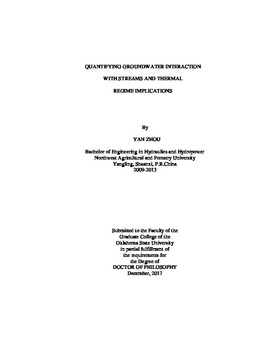| dc.contributor.advisor | Fox, Garey | |
| dc.contributor.author | Zhou, Yan | |
| dc.date.accessioned | 2018-06-18T16:02:30Z | |
| dc.date.available | 2018-06-18T16:02:30Z | |
| dc.date.issued | 2017-12 | |
| dc.identifier.uri | https://hdl.handle.net/11244/300083 | |
| dc.description.abstract | Groundwater interaction plays an essential role in aquatic ecosystems and is involved in a range of water quantity and quality issues. However, quantifying stream-groundwater interactions has been difficult and labor intensive due to the complex nature of the hydrological connectivity. Therefore, there remains considerable need for advancements that can help understand and quantify groundwater interaction with lower cost, better flexibility and convenience. The objectives of this study were to (i) understand the transient storage mechanisms due to surface exchange and hyporheic flow by applying a stream transient storage zone model to soil pipe systems; (ii) develop the thermal equilibrium method to estimate the time-averaged point groundwater flux using monitored stream water temperature at a single point and existing atmospheric and hydrological data and (iii) evaluate the effects of reservoir operations in the Kiamichi River as related to stream fish thermal tolerances during summer baseflow conditions with an emphasis of groundwater interactions. Tracer data from a pulse input were collected in four different soil pipes after a fluorescein dye was injected upstream of each soil pipe network. The transient storage zone model OTIS-P was successfully applied to estimate solute transport parameters. The result suggested larger transient storage potential compared to stream systems reported in previous research. In the second part, a thermal equilibrium method was developed to quantify point groundwater flux in streams, and was evaluated by comparing with measurements from seepage runs. Statistics evaluated by FITEVAL indicated result from two methods agreed with each other, and the thermal equilibrium method was proven to be a suitable technique for quantifying point groundwater flux. In the third part, the WASP stream temperature model was calibrated and validated for four summers with an emphasis of groundwater interactions. Downstream water temperature was predicted using the validated model for 15 hypothetical release scenarios and evaluated based on critical thermal maximum of three fish guilds. Results indicated the current release operation was insufficient to provide a suitable downstream thermal regime for most of the fishes tested. Increasing release magnitude and/or releasing from hypolimnetic layers could improve the downstream thermal habitat for these fishes. | |
| dc.format | application/pdf | |
| dc.language | en_US | |
| dc.rights | Copyright is held by the author who has granted the Oklahoma State University Library the non-exclusive right to share this material in its institutional repository. Contact Digital Library Services at lib-dls@okstate.edu or 405-744-9161 for the permission policy on the use, reproduction or distribution of this material. | |
| dc.title | Quantifying groundwater interaction with streams and thermal regime implications | |
| dc.contributor.committeeMember | Brewer, Shannon | |
| dc.contributor.committeeMember | Storm, Daniel | |
| dc.contributor.committeeMember | Zou, Chris | |
| osu.filename | Zhou_okstate_0664D_15482.pdf | |
| osu.accesstype | Open Access | |
| dc.type.genre | Dissertation | |
| dc.type.material | Text | |
| thesis.degree.discipline | Biosystems and Agricultural Engineering | |
| thesis.degree.grantor | Oklahoma State University | |
